"Cherishing Little Steps - A Haven for Baby and Family Journeys"
Maternity Compression Socks
Looking for a way to stay comfortable and stylish during your pregnancy? Look no further than maternity compression socks.
These innovative socks not only provide support and relieve swelling, but they also offer a fashionable touch to your maternity wardrobe.
With their unique design and effective compression technology, maternity compression socks are a must-have for any expecting mother.
Discover the benefits and learn how to choose the right pair in this informative article.
Key Takeaways
- Maternity compression socks provide support, relieve swelling, improve blood circulation, and aid in postpartum recovery.
- These socks work by applying gentle pressure, squeezing veins and muscles, reducing swelling, fatigue, and discomfort in the legs and feet.
- When choosing maternity compression socks, consider size, desired level of compression, materials, additional features, and refer to size charts provided by brands.
- Maternity compression socks should be worn throughout the day, especially if on feet for long periods or experiencing swelling, and should be removed if necessary to avoid adverse effects.
Benefits of Maternity Compression Socks
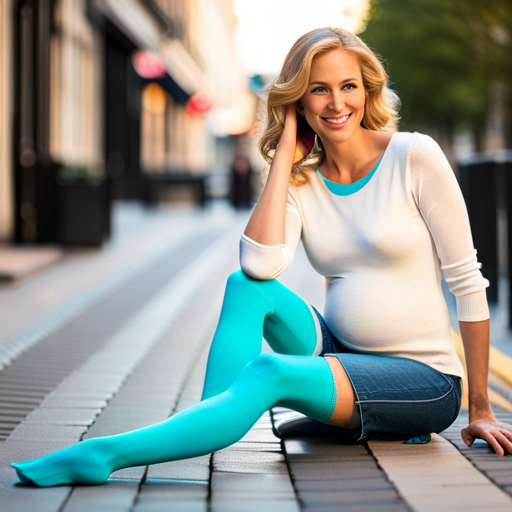
You should definitely consider wearing maternity compression socks during pregnancy as they provide significant benefits for your circulation and reduce swelling in your legs and feet.
These socks are specially designed to apply gentle pressure to your lower legs, ankles, and feet, which helps improve blood circulation and prevent blood from pooling in your lower extremities. By promoting better circulation, maternity compression socks can greatly reduce discomfort caused by swollen legs and feet.
During pregnancy, hormonal changes and increased blood volume can lead to poor circulation, resulting in swollen and achy legs and feet. Maternity compression socks work by applying graduated pressure, meaning that the pressure is strongest at the ankle and gradually decreases towards the calf. This helps to push the blood back up towards the heart, preventing it from pooling in the legs and reducing swelling.
In addition to reducing discomfort, improved blood circulation provided by maternity compression socks can also help prevent more serious conditions such as deep vein thrombosis (DVT) and varicose veins. DVT is a potentially dangerous condition where blood clots form in the deep veins, while varicose veins are swollen and twisted veins that can cause pain and discomfort.
How Maternity Compression Socks Work

Wearing maternity compression socks can be beneficial for pregnant women as they work by applying gentle pressure to improve blood circulation and reduce swelling in the legs and feet.
During pregnancy, many women experience discomfort due to the increased weight and pressure on their lower extremities. However, by wearing compression socks, you can effectively manage these discomforts and enhance your overall well-being.
Compression socks are designed to provide graduated compression, meaning that the pressure is highest at the ankle and gradually decreases as it moves up the leg. This design helps to promote better blood flow by squeezing the veins and muscles in the legs, allowing blood to circulate more efficiently. As a result, you may experience reduced swelling, less fatigue, and minimized discomfort in your legs and feet.
Furthermore, these socks can provide additional support to your feet and ankles, which are often subjected to increased stress during pregnancy. By stabilizing these areas, compression socks can help alleviate pain and prevent potential injuries.
Incorporating compression socks into your daily routine can significantly improve your pregnancy experience. Not only do they offer relief from managing pregnancy discomfort, but they also provide a proactive approach to addressing potential health issues.
Choosing the Right Maternity Compression Socks

When selecting maternity compression socks, consider factors such as your size, desired level of compression, and the material they’re made of to ensure optimal comfort and effectiveness. With so many maternity compression socks brands available in the market, it can be overwhelming to choose the right one. That’s why it’s important to have a buying guide for maternity compression socks to help you make an informed decision.
Firstly, consider your size when purchasing maternity compression socks. It’s essential to choose the right size to ensure a proper fit and maximum support. Measure your calf circumference and refer to the size chart provided by the brand to find the perfect fit.
Next, determine the desired level of compression. Maternity compression socks come in different levels of compression, ranging from mild to moderate to firm. Mild compression is suitable for daily wear, while moderate to firm compression is beneficial for relieving swelling and discomfort.
Lastly, pay attention to the material of the socks. Look for breathable and moisture-wicking fabrics such as nylon or spandex, which provide comfort and prevent odor. Additionally, some brands offer specific features like seamless construction or anti-slip bands for added convenience.
When to Wear Maternity Compression Socks
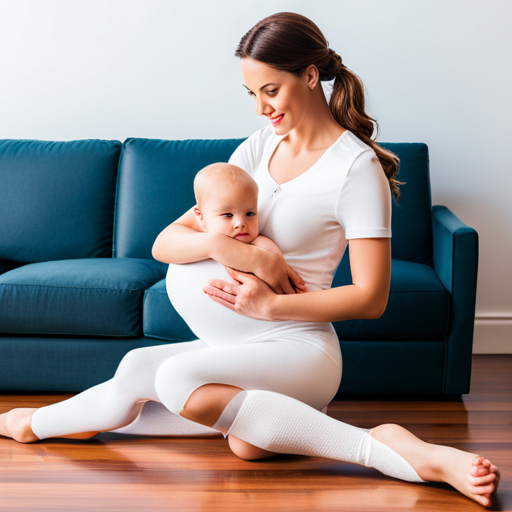
Make sure to consult with your healthcare provider to determine the appropriate time to wear maternity compression socks during your pregnancy. Maternity compression socks are designed to provide support, improve blood circulation, and reduce swelling in the legs and feet. However, it’s important to know when to remove them to avoid any adverse effects.
Typically, it’s recommended to wear maternity compression socks throughout the day, especially if you’re on your feet for long periods or experiencing swelling. However, it’s essential to listen to your body and adjust accordingly. If you notice any discomfort or tightness, it may be a sign that it’s time to remove the socks and give your legs a break.
Additionally, there are alternatives to maternity compression socks that you can consider. Maternity compression stockings are a popular choice, as they offer similar benefits but are more discreet and can be worn with any type of footwear. Some women also find relief by elevating their legs, practicing gentle exercises, or using cold compresses.
Tips for Properly Wearing Maternity Compression Socks
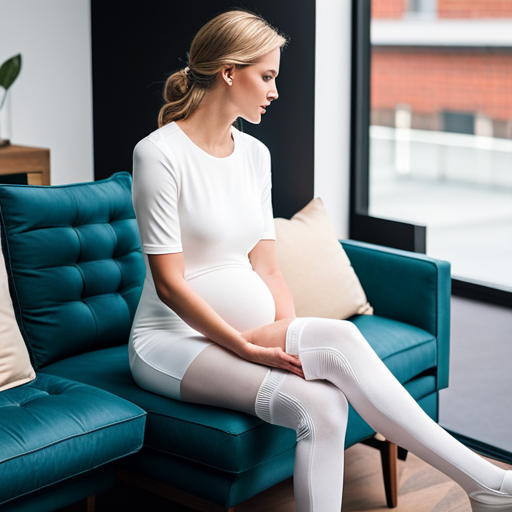
To maximize the benefits of maternity compression socks, try wearing them consistently throughout the day and coordinating your outfits accordingly. Maternity compression socks are designed to provide support and improve circulation during pregnancy, but many women struggle with putting them on and have misconceptions about their effectiveness.
Here are some tips for properly wearing maternity compression socks and debunking common misconceptions.
Firstly, when putting on maternity compression socks, make sure to sit or lie down to avoid unnecessary strain on your body. Roll the sock down to the heel, then insert your foot and gradually roll the sock up. It’s important to ensure that the socks fit snugly but not too tight, as this can restrict blood flow.
Contrary to popular belief, maternity compression socks can be fashionable too! Coordinate your outfits with your compression socks to incorporate them seamlessly into your wardrobe. Many brands offer a variety of colors and patterns to choose from, allowing you to stay stylish while reaping the benefits of compression.
Another misconception is that maternity compression socks are only needed during the later stages of pregnancy. In reality, wearing them from the early stages can help prevent swelling, varicose veins, and discomfort throughout your pregnancy.
Managing Swelling With Maternity Compression Socks
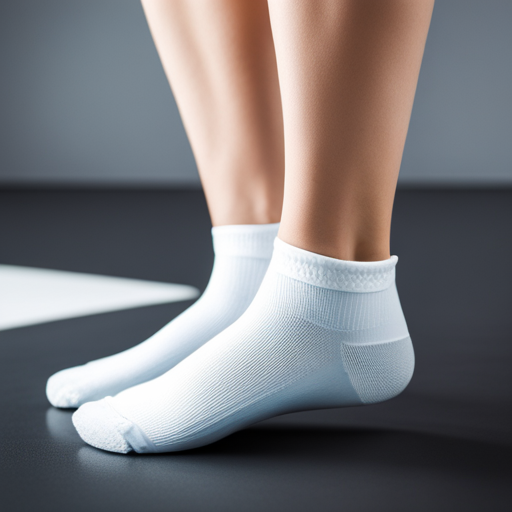
You can effectively manage swelling during pregnancy by wearing maternity compression socks and incorporating them into your daily routine. These socks are designed to apply gentle pressure to your legs, ankles, and feet, promoting better blood circulation and reducing swelling.
Here are some alternative swelling management techniques during pregnancy that you can consider:
-
Elevate your legs: By lying down and propping your legs up on pillows, you can help reduce swelling by allowing gravity to assist in the circulation of blood and fluid.
-
Stay hydrated: Drinking plenty of water can help flush out excess fluids from your body, reducing swelling in the process.
-
Avoid standing or sitting for long periods: Prolonged periods of inactivity can contribute to swelling. Make sure to take breaks and move around to keep the blood flowing.
-
Wear loose-fitting clothing and shoes: Tight clothing and shoes can restrict blood flow, leading to swelling. Opt for comfortable, breathable fabrics and shoes that provide adequate support.
In addition to managing swelling during pregnancy, maternity compression socks can also have a positive impact on postpartum recovery. The compression technology helps reduce postpartum swelling and discomfort, promoting faster healing and alleviating pain.
Incorporating maternity compression socks into your daily routine during pregnancy and after childbirth can greatly improve your overall well-being.
Maternity Compression Socks Vs Regular Socks: What’s the Difference
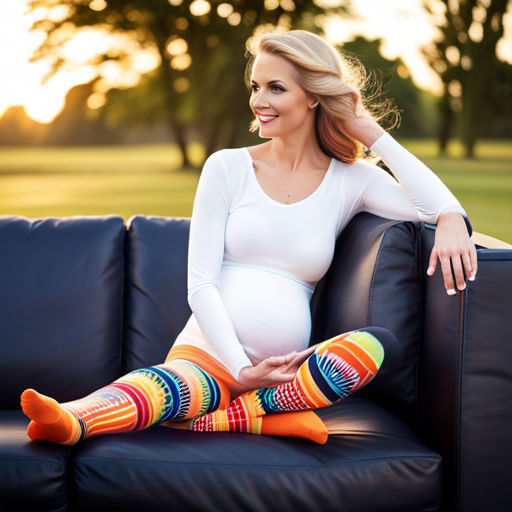
If you’re wondering about the difference between maternity compression socks and regular socks, the key lies in the level of pressure and support they provide. Maternity compression socks are specially designed to offer increased pressure and support to the legs and feet during pregnancy. Regular socks, on the other hand, aren’t designed with the same level of compression and support.
The importance of wearing maternity compression socks can’t be overstated. During pregnancy, the body undergoes numerous changes, including increased blood volume and hormonal shifts. These changes can lead to swelling and discomfort in the legs and feet. Maternity compression socks help improve blood circulation by applying gentle pressure to the legs, reducing swelling, and promoting overall comfort.
Regular socks, while suitable for everyday use, don’t offer the same benefits as maternity compression socks. They may not provide enough support or compression to alleviate pregnancy-related swelling and discomfort. Maternity compression socks, on the other hand, are specifically designed to address the unique needs of pregnant women, providing targeted support and compression where it’s needed most.
Styling Maternity Compression Socks: Fashionable and Functional

The key to styling maternity compression socks is finding a balance between fashionable and functional. Maternity compression socks are designed to provide support and improve blood circulation during pregnancy, but that doesn’t mean you have to sacrifice style. Here are some tips to help you rock your maternity compression socks while staying on-trend:
-
Fashion trends: Keep up with the latest fashion trends and incorporate them into your maternity compression sock outfits. Look for socks with trendy patterns or designs that complement your maternity wardrobe.
-
Color options: Maternity compression socks come in a variety of colors, so don’t be afraid to experiment. Opt for neutral colors like black, gray, or nude for a classic and versatile look. If you’re feeling bold, go for vibrant colors or fun prints to add a pop of personality to your outfit.
-
Layering: Maternity compression socks can be worn under pants or skirts, so you can easily incorporate them into your everyday outfits. Try pairing them with a flowy dress or a skirt for a chic and feminine look.
-
Accessorize: Don’t forget to accessorize! Add some flair to your maternity compression sock ensemble with cute shoe accessories, like bows or clips. You can also pair them with stylish shoes that complement your outfit.
Frequently Asked Questions
Are Maternity Compression Socks Safe to Wear During Pregnancy?
During pregnancy, it is safe to wear maternity compression socks. They provide numerous benefits, such as reducing swelling and improving blood circulation. To ensure the right fit, choose the appropriate size for maximum effectiveness.
Can Maternity Compression Socks Help With Varicose Veins?
Improve your blood circulation and say goodbye to varicose veins with maternity compression socks. These socks provide numerous benefits during pregnancy, including reducing swelling and discomfort. Say hello to healthier legs!
How Long Should I Wear Maternity Compression Socks Each Day?
You should wear maternity compression socks for a few hours each day to experience the benefits they offer during pregnancy. It’s important to choose the right size and fit to ensure maximum comfort and effectiveness.
Can I Sleep in Maternity Compression Socks?
Yes, you can sleep in maternity compression socks. Wearing them while exercising can improve blood circulation and reduce swelling in your ankles. They provide support and comfort throughout the night, promoting better rest and recovery.
Are There Any Side Effects of Wearing Maternity Compression Socks?
Wearing maternity compression socks may have potential risks and discomfort levels. It’s important to be aware of any side effects that could arise from using these socks to ensure your comfort and well-being.
Conclusion
In conclusion, maternity compression socks are a must-have accessory for expectant mothers.
Not only do they provide numerous benefits such as reducing swelling and improving circulation, but they’re also stylish and fashionable.
Think of them as a supportive hug for your legs, keeping you comfortable and helping you stay on your feet throughout your pregnancy journey.
So, why wait? Embrace the power of maternity compression socks and step into motherhood with confidence and style.


